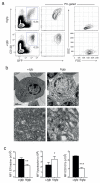Blimp-1 controls plasma cell function through the regulation of immunoglobulin secretion and the unfolded protein response
- PMID: 26779600
- PMCID: PMC4757736
- DOI: 10.1038/ni.3348
Blimp-1 controls plasma cell function through the regulation of immunoglobulin secretion and the unfolded protein response
Abstract
Plasma cell differentiation requires silencing of B cell transcription, while it establishes antibody-secretory function and long-term survival. The transcription factors Blimp-1 and IRF4 are essential for the generation of plasma cells; however, their function in mature plasma cells has remained elusive. We found that while IRF4 was essential for the survival of plasma cells, Blimp-1 was dispensable for this. Blimp-1-deficient plasma cells retained their transcriptional identity but lost the ability to secrete antibody. Blimp-1 regulated many components of the unfolded protein response (UPR), including XBP-1 and ATF6. The overlap in the functions of Blimp-1 and XBP-1 was restricted to that response, with Blimp-1 uniquely regulating activity of the kinase mTOR and the size of plasma cells. Thus, Blimp-1 was required for the unique physiological ability of plasma cells that enables the secretion of protective antibody.
Figures







References
-
- Tarlinton D, Radbruch A, Hiepe F, Dorner T. Plasma cell differentiation and survival. Curr Opin Immunol. 2008;20:162–169. - PubMed
-
- MacLennan IC, et al. Extrafollicular antibody responses. Immunol Rev. 2003;194:8–18. - PubMed
-
- Hammarlund E, et al. Duration of antiviral immunity after smallpox vaccination. Nat Med. 2003;9:1131–1137. - PubMed
-
- Bettigole SE, Glimcher LH. Endoplasmic reticulum stress in immunity. Annu Rev Immunol. 2015;33:107–138. - PubMed
-
- Nutt SL, Hodgkin PD, Tarlinton DM, Corcoran LM. The generation of antibody-secreting plasma cells. Nat Rev Immunol. 2015;15:160–171. - PubMed
Publication types
MeSH terms
Substances
Grants and funding
LinkOut - more resources
Full Text Sources
Other Literature Sources
Molecular Biology Databases
Miscellaneous

